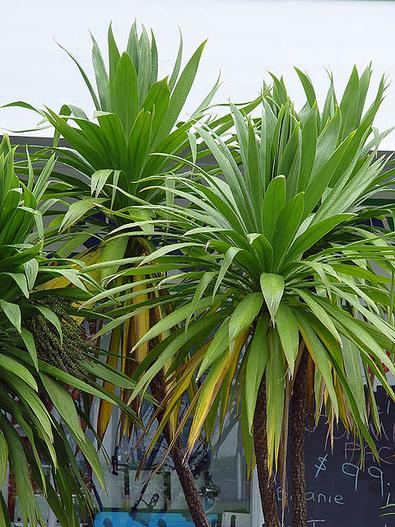Norfolk Island Cabbage Tree
(Cordyline obtecta)
Norfolk Island Cabbage Tree (Cordyline obtecta)
/
/

tanetahi
CC BY 2.0
Image By:
tanetahi
Recorded By:
Copyright:
CC BY 2.0
Copyright Notice:
Photo by: tanetahi | License Type: CC BY 2.0 | License URL: https://creativecommons.org/licenses/by/2.0/ | Uploader: tanetahi | Publisher: Flickr















Estimated Native Range
Summary
Cordyline obtecta, commonly known as Norfolk Island Cabbage Tree, is an evergreen tree native to Norfolk Island and northern New Zealand, including the Three Kings Islands. It is typically found in open woodlands and coastal forests, where it contributes to the unique ecology of these regions. The tree can grow up to 10 meters (33 ft) tall, usually less, with a stout trunk 20–30 centimeters (7.9–11.8 in) in diameter. It features spreading branches with densely clustered, stiff leaves that form tufts at the branch tips. The cream and white flowers are showy due to their large, open-branched panicles that emerge among the leaves, each flower being about 1 millimeter (0.039 in) in diameter and emitting a strong fragrance. Flowering occurs in the summer season. The fruit is a spherical berry, 4–5 millimeters (0.16–0.20 in) in diameter, turning from whitish to purplish blue upon maturity. The bark is grey and flaky, adding to the tree’s ornamental value.
The Norfolk Island Cabbage Tree is valued for its architectural form and fragrant, showy flowers. It is used in urban planting, as a specimen tree in gardens, and increasingly as a street tree. The tree’s tolerance for salt spray also makes it suitable for coastal planting. It requires well-drained soils and is sensitive to frost and wet conditions, making it best suited for milder climates. Cultivars like ’Green Goddess’ and ’Emerald Goddess’ offer variations in leaf color and panicle form, expanding its use in horticulture. In cultivation, it thrives in full sun to part shade, with moderate watering, and prefers soils with good drainage.CC BY-SA 4.0
The Norfolk Island Cabbage Tree is valued for its architectural form and fragrant, showy flowers. It is used in urban planting, as a specimen tree in gardens, and increasingly as a street tree. The tree’s tolerance for salt spray also makes it suitable for coastal planting. It requires well-drained soils and is sensitive to frost and wet conditions, making it best suited for milder climates. Cultivars like ’Green Goddess’ and ’Emerald Goddess’ offer variations in leaf color and panicle form, expanding its use in horticulture. In cultivation, it thrives in full sun to part shade, with moderate watering, and prefers soils with good drainage.CC BY-SA 4.0
Plant Description
- Plant Type: Tree
- Height: 2-3 feet
- Width: 2-3 feet
- Growth Rate: Moderate
- Flower Color: Cream, White
- Flowering Season: Summer
- Leaf Retention: Evergreen
Growth Requirements
- Sun: Full Sun, Part Shade
- Water: Medium
- Drainage: Medium
Common Uses
Bee Garden, Bird Garden, Border Plant, Butterfly Garden, Drought Tolerant, Fragrant, Low Maintenance, Potted Plant, Salt Tolerant, Street Planting
Natural Habitat
Native to coastal forests and open woodlands of Norfolk Island and northern New Zealand
Other Names
Common Names: Three Kings Cabbage Tree
Scientific Names: , Cordyline baueri, Cordyline obtecta, Cordyline kaspar, Dracaena obtecta, Euphyleia odorata, Terminalis obtecta,
GBIF Accepted Name: Cordyline obtecta (Graham) Baker